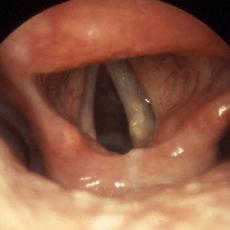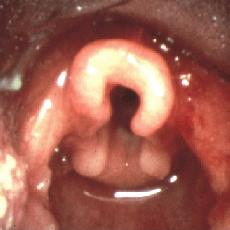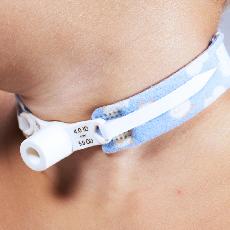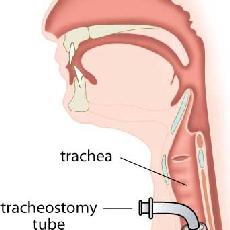
|
Otorhinolaryngology Otorhinolaryngology |
Airway
Stridor
Stridor is a harsh noise produced by turbulent airflow through a partially obstructed upper airway
It is commonly inspiratory indicating an obstruction at the larynx
Note: expiratory and biphasic stridor are rarer and imply obstruction at the level of the trachea and subglottis
We will focus on paediatric presentations of stridor
Aetiology
In a child the differential diagnosis is (using a surgical sieve):
Traumatic: Foreign body
Autoimmune/allergic: Anaphylaxis
Infective: Laryngotracheobronchitis (croup), tracheitis, supraglottitis/epiglottitis, DNSI (see head and neck section)
Neoplastic
- Benign: respiratory papillomatosis/vocal fold papilloma, vocal fold cysts & nodules (see hoarseness section)
Congenital: Laryngomalacia, laryngeal web, vocal cord paralysis, subglottic stenosis (can be secondary to prolonged intubation)
Stridor should be treated as a medical emergency
In adults the following are the most common causes of stridor:
- Anaphylaxis
- Foreign body
- Trauma e.g. laryngeal fracture
- DNSI
- Malignancy: laryngeal or mediastinal
- Benign external compression e.g. goitre
Chronic stridor in an adult should raise concern and malignancy needs to be excluded
Laryngomalacia
- Stridor occurs as a result of prolapse of the supraglottic structures into the laryngeal inlet on inspiration
- Most common cause of stridor in infants and most common congenital laryngeal abnormality
- Majority of infants can be managed conservatively. ~10% require surgery

Normal larynx |

Laryngomalacia |
Compare this picture of a normal larynx to the picture of the larynx with laryngomalacia Note the change in size of the airway

Picture of flexible nasolaryngoscopic examination of a patient with laryngomalacia
- The epiglottis is omega-shaped and folded upon itself to that the lateral margins lie close to one another
- The aryepiglottic folds are foreshortened and thin
- The arytenoids are large with redundant mucosa
- Mucosal oedema from vibratory trauma to the supraglottic area exacerbates the symptoms

Laryngeal web
- Congenital condition that presents with an abnormal cry and stridor
- Arises from the failure of the recanalization of the larynx in the embryo
- Treatment is with incision for thinner webs; thicker webs may require stenting
Subglottic stenosis
- This is the partial or complete narrowing of the subglottic area - which is the narrowest portion of the airway in children
- Congenital - present with stridor at birth or intermittent stridor if mild stenosis e.g. only with URTI
or
Acquired - commonly secondary to prolonged endotracheal intubation (~90% of cases) - Lateral neck X-ray can show stenosis
- Treatment is dictated by age of patient, grade and type of stenosis
Procedures range from observation for mild cases to laryngotracheal reconstruction for severe cases
Tracheostomy


| « Laryngology | Voice » |





